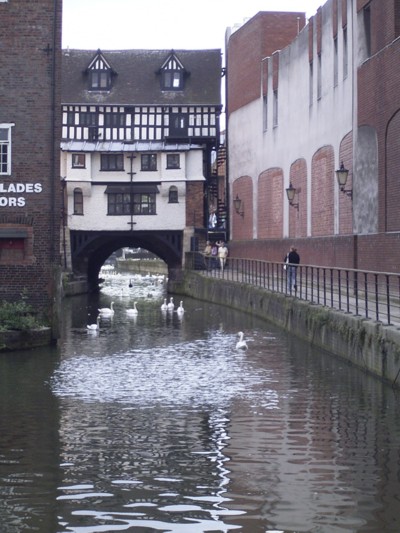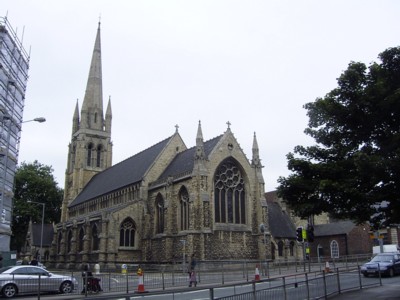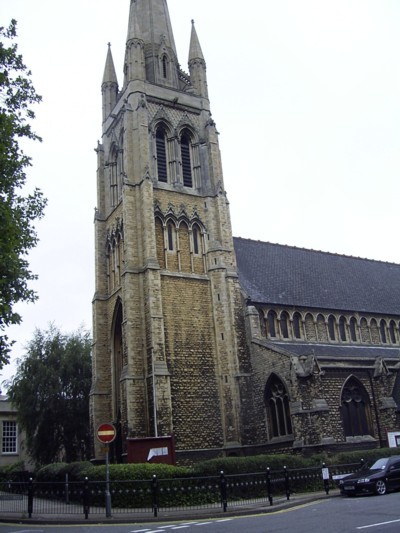
Brayford pool
Page 4. So I return to Anne Wells and Matthias Graham and the life they would have led. Having found from his marriage certificate that William’s father was Matthias Graham, I typed that name into an Internet search engine and found the following:
So here would be an answer to the question of why my grandmother Phoebe Exley had "married below herself" and as to why the name of "father" on William’s death certificate is shown as "unknown". We had a convict skeleton in the closet.
Anne and Matthias were having their family at a time of great social change in England. In feudal times unused lands known as "commons" were allotted to the serfs and peasants as common grazing grounds. Around Doddington in the early 1800s these lands were still in use by people such as Anne and Matthias who were able to supplement their meager incomes by using the common land for keeping sheep or a cow, for growing crops or gathering wood for fuel. The agricultural revolution saw new methods of farming coming into use. The horse-drawn hoe and mechanical seeder were invented and fertilizers and crop rotation methods were being used. In order for farmers to make the most efficient use of the land, Enclosure Acts came into force, dispossessing peasant farmers of their common lands. At the same time, the Industrial revolution was taking place and so the dispossessed farmers were forced to find work in the factories which began springing up in towns and cities.
The area of Skellingthorpe, where Matthias was working in 1814 was finally enclosed in 1830. It is not surprising, therefore, to find his family living in Lincoln in 1823 at an address shown as, "the Foundry yard".

Brayford pool

St Swithin’s Church, Lincoln

St Swithin’s Church, Lincoln
Anne and Matthias had a hard life. John, their first born, only lived four days, dying on 11 January 1815 and being buried in the church in which he was christened days earlier. Sarah, their third child, died on 22 February 1823 at two years of age; Job, their sixth child died on 22 March 1828 at one year, and their fourth child Isaac died on 14 July 1839 at 15 years. It is interesting to note that one-year-old Job died at "Union Place". Union Place no longer exists in Lincoln but was quite likely the present day Union Road and the address of the Union Poor House. It is likely that Anne took the child there in order to get medical assistance for him. It was the practice in those days to name a subsequent child after one that had died and another Job was born to them, one of twins. Between 1840 and 1841 however, he also died.
Times would clearly have been hard for them as Matthias had had a serious accident. He is described in the record in Jedburgh as having a small scar over his left eyebrow; a large broad scar on his left cheek; a missing left thumb; a contracted left hand and a scar on his left kneecap. I cannot imagine a foundry employing somebody who was already in this state and am inclined to think that this accident happened to him in the factory. From 1821 his children were christened or buried at St Swithins church in Lincoln so he and Anne left the country life of Doddington between Henry’s birth in 1818 and Sarah’s birth in 1821. Children were born to them every two years until 1828 when Job died, probably in the Poor House and was buried at St Swithins. Perhaps this is when the accident happened to Matthias that caused such severe injuries to the left side of his body. From here on their life becomes unsettled. Anne goes to Boston for the birth of Elizabeth in 1829, is back in Lincoln for the birth of Ann in 1830 and then no other children are born to them until 1836. We know that Matthias had three periods in prison before he was finally transported to Australia. He was sentenced to two periods of three months imprisonment and one period of six months. Perhaps it was during one of these episodes of imprisonment that Anne went to Boston. It seems very likely that imprisonment is the reason for the six year gap between Ann in 1830 and the twins in 1836. I wonder if the injuries he had suffered and the difficulties he would have faced feeding his surviving children were the reason for his criminal activity.
Somewhere between 1840 and 1841 the twin Job died. At the beginning of 1839 they had 7 children surviving of 10, aged 20, 15, 13, 10, 9 and two 3-year-olds. It was on 22 February 1839 that, for whatever reason, Matthias Graham committed the crime that would separate him forever from his wife and young family when he stole 13 fowls from two cottages in the village of Eagle.
The original Lincoln Castle Keepers Journal entry [C 5/1/3 (vol) (22/2/39)] of 22 February 1839 can be viewed at the Lincolnshire Archives. It states:
It seems that "20" may be a mistake as other entries regarding his crime report 2 fowls stolen from Robert Toft.